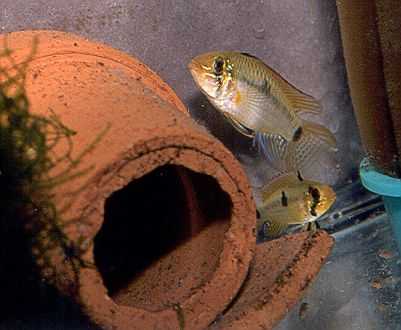
Apistogramma steindachneri - male above
Babies are just leaving the cave - parents are on guard
Watchful parents - Note the male caudal extensions
Two of the orginal six fry
|
This might have been our second Apisto because, many years back we kept and spawned the Blue Ram, (formerly Apistogramma ramirezi), but no less an authority than Herbert Axelrod moved it into another genus, (Microgeophagus) and left us Apisto-less. Dwarf South American cichlids of which the Apistogramma genus forms an important part, have become a passion for many fine hobbyists. There is even an Apistogramma Study Group with its own webpage and a publication known as the Apisto-Gram. Still, few Apistos ever turn up in our local pet stores. Most of these diminutive beauties seem to require fairly soft acid water and typically they don't have huge spawns. These are characteristics that may make them less desirable as a fish farm product and leave them more expensive and less available to the pet stores. At any rate they have not become one of the 'bread and butter' fish in our area as yet. The pair we acquired were brought to our fall auction by Judy and Leighton Irwin of Orillia and they were in excellent shape. It was one of those 'buyer's auctions' and this bag of Steindachner's Dwarf Cichlids, which might normally have gone well beyond our budget, were to be had for a very modest price. I'd have felt guilty but we didn't get much for our fish either. Full grown males only get about 3-1/2 inches long with females at least 1/2 inch shorter so it's pretty easy to tell the sexes apart. If that's not enough the male has a bit longer finnage, including slight extensions near the top and bottom of his tail, and the female has a shorter, more rounded tail. They are both marked by a black stripe through the eye and substantial spots on the side and the caudal peduncle. These become very pronounced when they are breeding and their bodies take on a bright yellow tone. The books suggest more than one female per male but we only had one so we set them up in a 2 1/2 gallon tank with a dark background. Filtration was provided by a well-used sponge filter. A bunch of Java Moss and a cave made from a small clay pot provided hiding possibilities and a potential spawning sight. Their water was mostly soft RO (Reverse Osmosis) buffered to about 6.5 pH. We fed them a variety of freeze dried foods, live foods, (daphnia, whiteworms and baby brine shrimp), and some sinking pellets. A small syphon tube was used each day to remove any uneaten food and do general clean up. Whatever water was removed in the process was replaced with fresh. These are normally peaceful, even shy little fish so when they turned bright yellow and the male started attacking the syphon tube, I should have realized what was up but I didn't. They spawn in a cave and my discovery that a spawning had taken place came while I was looking at a photograph of their tank that I'd taken a few days before. As it happened there was a rather bad reflection on the glass which pretty well spoiled the picture and I examined it carefully to see if any part of it could be of use. There, behind the reflection, were some unmistakable fry. I dropped the photo and went down to the fish room for a look at the real thing. Sure enough, there was a spawn, actually 2 spawns, (a few babies were much larger than the others). I'm sorry I can't tell you how many eggs were laid or what size and colour they were. Not wanting to disrupt the process we have not disturbed the 'cave' and so, have not actually seen the eggs. (If they continue spawning, when we have all the babies we want, we'll take a peek and note those details.) What I can tell you is one mistake to avoid. I found, by accident, that it was easy to syphon the babies out and I used that method to move them to a small, (2 1/2 gal.), tank of their own. There were approximately 30 fry and over the next week or so all but the 6 larger ones disappeared. I never witnessed any seriously aggressive behaviour but only one dead body was found so the conclusion seems to be that successive spawns should not be left together. At least not out from under the watchful eyes of the parents who are both active in providing parental care. We have also concluded that a larger tank is desirable to raise the fry. Those six survivors have grown rapidly and are now easily sexable but six is not enough. Fortunately mother and father did it again and this time we knew what was happening. Mistakes are only bad if you don't learn from them. This time we waited until the fry were showing some independence and were obviously pigging out on brine shrimp nauplii as evidenced by their swollen pink bellies. Then we matched water and moved them to a 10 gallon tank. There were 20 this time and, except for one that got damaged in the move, they seem to be doing very well. (No disappearances!) This has been our first but, hopefully, not our last Apistogramma. We know from perusing the literature that spawns of over 200 babies are not impossible for steindachneri. However, larger breeding tanks were used and perhaps our young pair have not done so badly in their 2 1/2 gallons.Update as of mid June '99: The Apisto pair have spawned again and we had a look inside the pot. We counted approx. 80 small red eggs. |